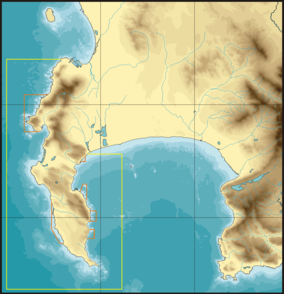| Table Mountain National Park Marine Protected Area | |
|---|---|
IUCN category IV (habitat/species management area) | |
 | |
 Table Mountain National Park Marine Protected Area location | |
| Location | Coastal, Western Cape, South Africa |
| Nearest city | Cape Town |
| Coordinates | 34°00′S 18°20′E / 34.000°S 18.333°E |
| Area | 953.25 km2 (368.05 sq mi) |
| Established | Proclaimed under the MLRA in 2004 |
| Governing body | SANParks |
| World Heritage site | Cape Floral Region (terrestrial) |
The Table Mountain National Park Marine Protected Area is an inshore marine protected area around the Cape Peninsula, in the vicinity of Cape Town, South Africa. It was proclaimed in Government Gazette No. 26431 of 4 June 2004 in terms of the Marine Living Resources Act, 18 of 1998.[1]
The MPA is of value for conservation of a wide range of endemic species, and has considerable economic value as a tourist destination. It encloses a large number of recreational dive sites visited by local residents and tourists from further afield. The shark and whale watching tourist industries are also represented, and there are several popular surf breaks. The MPA is mainly a controlled zone where extractive activities are allowed under permit, with six small no-take zones. The MPA is administrated by the Table Mountain National Park, a branch of SANParks.
The marine ecology is unusually varied for an area of this size, as a result of the meeting of two major oceanic water masses near Cape Point, and the park extends into two coastal marine bioregions. The ecology of the west or "Atlantic Seaboard" side of the park is noticeably different in character and biodiversity to that of the east, or "False Bay" side. Both sides are classified as temperate waters, but there is a significant difference in average temperature, with the Atlantic side being noticeably colder on average.[2]
The MPA contains culturally significant fish traps, historical wrecks and traditional fishing communities, and is also important for commercial fisheries. Part of the West Coast rock lobster industry takes place within the MPA – as well as recreational and subsistence fishers, and an illegal poaching industry mostly targeting abalone, rock lobster and territorial linefish from the no-take zones.[2]
